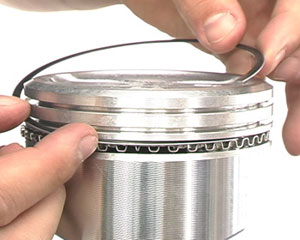 Chrome-plated cylinder liners are being used in increasing amounts, both by original equipment manufacturers, and by aftermarket sources.
Chrome-plated cylinder liners are being used in increasing amounts, both by original equipment manufacturers, and by aftermarket sources.
It is recommended that chrome-plated rings not be installed in chrome-plated liners under any circumstances. Catastrophic destruction will likely result. Plain cast iron-manganese phosphate coated, or molybdenum rings may be used. It is normally difficult to detect visually in a used cylinder if it is chrome plated or not.
If any doubt exists, a solution of copper sulfate (CuSO4), which can be purchased at any drugstore or chemical supply house, should be applied with a cotton swab to an area of the liner. If the liner is not plated, a copper color will appear. If it is chrome plated no change will take place. Never use chrome in chrome.
Cylinders are normally chrome plated for two reasons — to increase service life or to re-furbish worn liners.
Tech Tip courtesy of Hastings Piston Rings.













